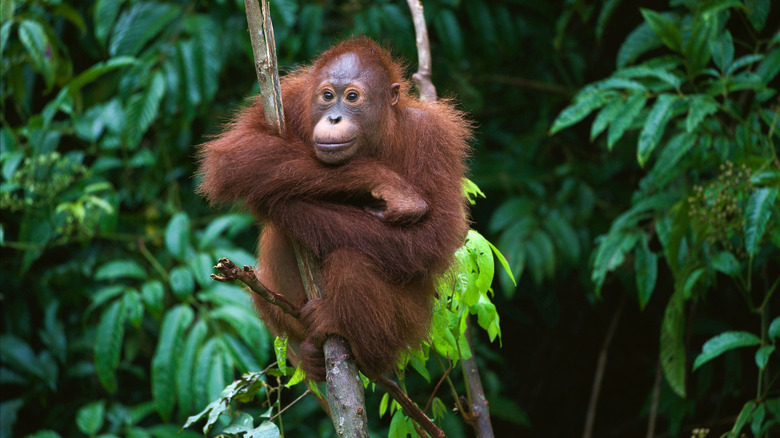This Rare Cat Was Caught On A Trail Cam And Scientists Are Thrilled
Endangered Species Day has been around since 2006, focusing on education and conservation regarding species that have had a population decline. It is a lovely coincidence that it was on Endangered Species Day that the conservation organization known as the Orangutan Foundation spotted something rare on one of its forest camera traps. It was not an orangutan, but a Bornean clouded leopard. Three to be exact. A mother and two babies.
The Orangutan Foundation posted the adorable camera footage on Instagram. The video was taken in the Tanjung Puting National Park in western Indonesia. This is extremely exciting news to see a thriving Bornean clouded leopard family in the wild. The species is listed as Vulnerable by the Union for Conservation of Nature. It also has protection under the Convention on International Trade in Endangered Species.
The Bornean clouded leopard faces threats in the form of deforestation and habitat loss. With all the additional problems being caused by climate change, it could drive shrinking animal populations even lower. Thanks to the work of organizations like the Orangutan Foundation, species such as the Bornean clouded leopard can live in peace.
The Bornean clouded leopard
Bornean clouded leopards live in the island forests of Borneo and Sumatra. It's difficult for scientists to get a clear picture of how many of these cats are living in the wild since they are so hard to spot. Estimates range from 8,000 to 18,000 across both islands according to data from the Felidae Conservation Fund. When comparing that population to other big cats, it's easy to get a picture of how small that is. Data from The Environmental Literacy Council shows there are 173,000 wild jaguars and 20,000 lions. Compare that even further to the existence of 1.5 billion cattle according to WorldAtlas and the problem of its small population becomes clear.
The Bornean clouded leopard gets its name from the cloud-like markings on its fur. It has the longest canine teeth out of any feline species, growing up to two inches in length. The fact that their tails are as long as their bodies helps them keep excellent balance in the trees of their forest home as they hunt for their next meal, which typically consists of the local monkeys, deer, and pigs.
Habitat loss — which also is a massive threat to humanity — isn't the only threat facing the Bornean clouded leopard. It is also in danger of being hunted by humans. Further, humans are also hunting the same food as the leopard, making its survival more difficult. Compounding its problems, the leopards have slow population growth, with few of their cubs surviving to reproductive age thanks to poaching.
What does the Orangutan Foundation do?
The footage of the Bornean clouded leopard family was captured by a camera trap placed by the Orangutan Foundation. The foundation has been around since 1990, with humble beginnings in London. Its mission focuses on helping orangutans need, including rescuing adult and orphan orangutans and successfully releasing them back into the wild. As this video shows, though, this foundation has its hands in other aspects of environmentalism.
One pillar of the Orangutan Foundation's work is on habitat conservation and restoration, but it also works very closely with the Indonesian Ministry of Forestry and the Tanjung Puting National Park wherein the leopard footage was captured. If you are interested in supporting the foundation's mission, you can do so by donating, helping fundraising efforts, or even by digitally adopting a real orangutan to help it get the care it needs.
Trails cams like the one the Orangutan Foundation deployed have been essential in capturing footage of elusive species in the past. By knowing where these animals are living and in what conditions, we can help to protect them in the future. Perhaps the babies of this mother Bornean clouded leopard will appear again when they are older.


